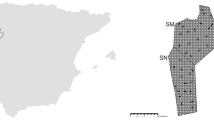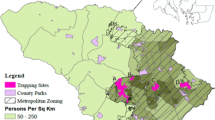Abstract
A method for obtaining a relative deer population density index with low cost and effort is urgently needed in wildlife protection areas that need their own deer management guidelines. We recorded the number of deer sighted during our daily trips on forest roads by car in Ashiu Forest at Kyoto University, Japan, beginning in 2006. We used generalized additive mixed models (GAMMs) to estimate among-year trends in the number of deer sighted. We applied models for the total number of deer (TND), number of adults (NA), and number of fawns (NF) sighted, which included both current-year and 1-year-old fawns. Full models included the terms of year (2007, 2008, 2009, and 2010), weather (fine, cloudy, and rain/snow), and nonlinear effects of season (date) and time (time). The optimal GAMMs for TND, NA, and NF did not include the effect of weather but included those of time, date, and year. The detected among-year trends in deer population may be influenced by differences in snow environments among the years. The modeling of road count data using GAMM quantitatively determined among-year variation in the number of deer sighted. This trend was similar to that of the population density estimated using a block count survey conducted in Ashiu Forest.




Similar content being viewed by others
References
Akashi N, Nakashizuka T (1999) Effects of bark-stripping by Sika deer (Cervus nippon) on population dynamics of a mixed forest in Japan. For Ecol Manag 113:75–82
Anderson DR (2001) The need to get the basics right in wildlife field studies. Wildl Soc Bull 29:1294–1297
Anderson DR (2003) Response to Engeman: index values rarely constitute reliable information. Wildl Soc Bull 31:288–291
Caley PA, Morley CG (2002) Assessing growth rates of European rabbit populations using spotlight transect counts. J Wildl Manag 66:131–137
Crawley MJ (2002) Statistical computing. An introduction to data analysis using S-Plus. Wiley, New York
Engeman RM (2003) More on the need to get the basics right: population indices. Wildl Soc Bull 31:286–287
Field Science Education and Research Center (2003) Outline of Ashiu Forest Research Station (in Japanese)
Field Science Education and Research Center (2007) Field Science Education and Research Center, Ashiu Station (in Japanese)
Field Science Education and Research Center (2008) Field Science Education and Research Center, Ashiu Station (in Japanese)
Field Science Education and Research Center (2009) Field Science Education and Research Center, Ashiu Station (in Japanese)
Field Science Education and Research Center (2010) Field Science Education and Research Center, Ashiu Station (in Japanese)
Field Science Education and Research Center (2011) Field Science Education and Research Center, Ashiu Station (in Japanese)
Fujiki D, Kishimoto Y, Sakata H (2010) Assessing decline in physical structure of deciduous hardwood forest stands under sika deer grazing using shrub-layer vegetation cover. J For Res 15:140–144
Fukuda A, Takayanagi A (2008) Influence of snow cover on browsing of Cephalotaxus harringtonia var. nana by Cervus nippon Temminck in heavy snow region in central Japan. For Res Kyoto 77:5–11 (in Japanese)
Gill RMA (1992) A review of damage by mammals in north temperate forests: 1. Deer. Forestry 65:145–169
Goda R, Mizuki I, Takayanagi A (2008) Road census for sika deer monitoring at the Ashiu Forest Research Station of Kyoto University. For Res Kyoto 77:89–94 (in Japanese)
Husheer SW, Coomes DA, Robertson AW (2003) Long-term influences of introduced deer on the composition and structure of New Zealand Nothofagus forests. For Ecol Manag 181:99–117
Kaji K, Takahashi H, Tanaka J, Tanaka Y (2005) Variation in the herd composition counts of sika deer. Popul Ecol 47:53–59
Kato M, Okuyama Y (2004) Changes in the biodiversity of a deciduous forest ecosystem caused by an increase in the Sika deer population at Ashu, Japan. Contrib Biol Lab Kyoto Univ 29:437–448
Martin TG, Wintle BA, Rhodes JR, Kuhnert PM, Field SA, Low-Choy SJ, Tyre AJ, Possingham HP (2005) Zero tolerance ecology: improving ecological inference by modelling the source of zero observations. Ecol Lett 8:1235–1246
McCullough DR (1982) Evaluation of night spotlighting as a deer study technique. J Wildl Manag 46:963–973
Nagata J (2010) Cervus Nippon Temminck, 1838. In: Ohdachi SD, Ishibashi Y, Iwasa MA, Saitoh T (eds) The wild mammals of Japan. Shoukadoh, Kyoto, pp 296–298
Nowak RM (1999) Walker’s mammals of the world, 6th edn. Jones Hopkins University Press, Baltimore
Pierce GJ, Santos MB, Smeenk C, Saveliev A, Zuur AF (2007) Historical trends in the incidence of strandings of sperm whales (Physeter macrocephalus) on North Sea coasts: an association with positive temperature anomalies. Fish Res 87:219–228
R Development Core Team (2009) R: a language and environment for statistical computing. R Foundation for Statistical Computing, Vienna
Rooney TP (2001) Deer impacts on forest ecosystems: a North American perspective. Forestry 74:201–208
Sage RW Jr, Tierson WC, Mattfeld GF, Behrend DF (1983) White-tailed deer visibility and behavior along forest roads. J Wildl Manag 47:940–953
Takatsuki S (1992) Foot morphology and distribution of Sika deer in relation to snow depth in Japan. Ecol Res 7:19–23
Takatsuki S, Matsuura Y (2000) Higher mortality of smaller sika deer fawns. Ecol Res 15:237–240
Takatsuki S, Suzuki K, Suzuki I (1994) A mass-mortality of sika deer on Kinkazan Island, northern Japan. Ecol Res 9:215–223
Tanaka Y, Takatsuki S, Takayanagi A (2008) Decline of Sasa palmata community by grazing of Sika deer (Cervus nippon) at Ashiu Research Forest Station. For Res Kyoto 77:13–23 (in Japanese)
Thompson WL, White GC, Schlegel MW, Carson RG (1998) Monitoring vertebrate populations. Academic, San Diego
Uno H, Kaji K, Saitoh T, Matsuda H, Hirakawa H, Yamamura K, Tamada K (2006) Evaluation of relative density indices for sika deer in eastern Hokkaido, Japan. Ecol Res 21:624–632
Uno H, Yokoyama M, Sakata H, The Working Group for Sika Deer Management, Mammalogical Society of Japan (2007) Current status of and perspectives on conservation and management for sika deer populations in Japan. Mamm Sci 47:25–38 (in Japanese with English summary)
Wood S (2010) R Package “mgcv version 1.7-2”
Yamamura K, Matsuda H, Yokomizo H, Kaji K, Uno H, Tamada K, Kurumada T, Saitoh T, Hirakawa H (2008) Harvest-based Bayesian estimation of sika deer populations using state-space models. Popul Ecol 50:131–144
Zuur AF, Ieno EN, Walker NJ, Saveliev AA, Smith GM (2009) Mixed effects models and extensions in ecology with R. Springer, New York
Acknowledgments
The authors thank all members who participated in this monitoring study. We are also grateful to R. Goda, A. Kimura, M. Ando, Y. Yoshikawa, and K. Fujisaki for their useful advice in planning this monitoring, and to the staff of the Ashiu experimental forest station for all of their support. Financial support was provided by the PRO NATURA FUND.
Author information
Authors and Affiliations
Corresponding author
About this article
Cite this article
Mizuki, I., Sakaguchi, S., Fukushima, K. et al. Among-year variation in deer population density index estimated from road count surveys. J For Res 18, 491–497 (2013). https://doi.org/10.1007/s10310-012-0379-5
Received:
Accepted:
Published:
Issue Date:
DOI: https://doi.org/10.1007/s10310-012-0379-5




